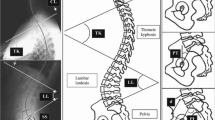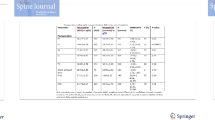Abstract
Purpose
Sagittal plane alignment is crucial for treating spinal malalignment and low back pain. Pelvic incidence–lumbar lordosis (PI–LL) mismatch is commonly used to evaluate clinical outcomes in patients with sagittal malalignment. The association between PI–LL mismatch and changes surrounding the intervertebral disc is very important to understand the compensatory mechanisms involved. This study aimed to examine the association between PI–LL mismatch and magnetic resonance imaging (MRI) changes surrounding the intervertebral disc in a large population-based cohort.
Methods
We evaluated participants from the second Wakayama Spine Study, recruiting the general population aged 20 years or older, irrespective of sex, who were registered residents in one region in 2014. In total, 857 individuals underwent an MRI of the whole spine; however, 43 MRI results were not included due to incomplete or inadequate quality images. PI–LL mismatch was defined as > 11°. We compared the MRI changes, such as Modic change (MC), disc degeneration (DD), and high-intensity zones (HIZ), between PI–LL mismatch and non-PI–LL mismatch groups. Multivariate logistic regression analysis was conducted to determine the association between the MRI changes and PI–LL mismatch with adjustment for age, sex, and body mass index in the lumbar region and at each level.
Results
A total of 795 participants (243 men, 552 women, mean age 63.5 ± 13.1 years old) were evaluated; 181 were included in the PI–LL mismatch group. MC and DD in the lumbar region were significantly higher in the PI–LL mismatch group. MC in the lumbar region was significantly associated with PI–LL mismatch (odds ratio (OR); 1.81, 95% confidence interval (CI) 1.2–2.7). MC at each level was significantly associated with PI–LL mismatch (OR; 1.7–1.9, 95%CI 1.1–3.2), and DD at L1/2, L3/4, and L4/5 was associated with PI–LL mismatch (OR; 2.0- 2.4. 95%CI 1.2–3.9).
Conclusion
MC and DD were significantly associated with PI–LL mismatch. Therefore, profiling MC may be helpful in improving the targeted treatment of LBP associated with the adult spinal deformity.
Similar content being viewed by others
References
Asai Y, Tsutsui S, Oka H, Yoshimura N, Hashizume H, Yamada H, Akune T et al (2017) Sagittal spino-pelvic alignment in adults: the Wakayama Spine study. PLoS ONE 12:e0178697. https://doi.org/10.1371/journal.pone.0178697
Xu L, Sun X, Huang S, Zhu Z, Qiao J, Zhu F, Mao S, Ding Y, Qiu Y (2013) Degenerative lumbar scoliosis in Chinese Han population: prevalence and relationship to age, gender, bone mineral density, and body mass index. Eur Spine J 22:1326–1331
Lagrone MMO, Bradford DS, Moe JH, Lonstein JE, Winter RB, Ogilvie JW (1988) Treatment of symptomatic flatback after spinal fusion. J Bone Joint Surg 70A:569–580
Dubousset J (1994) Three-dimensional analysis of the scoliotic deformity. In: Weinstein SL (ed) The pediatric Spine: principles and practice. Raven Press, New York
Glassman SD, Bridwell K, Dimar JR, Horton W, Berven S, Schwab F (2005) The impact of positive sagittal balance in adult spinal deformity. Spine 30(18):2024–2029. https://doi.org/10.1097/01.brs.0000179086.30449.96
Hira K, Nagata K, Hashizume H, Asai Y, Oka H, Tsutsui H, Takami M (2021) Relationship of sagittal spinal alignment with low back pain and physical performance in the general population. Sci Rep 11:20604
Barrey C, Roussouly P, Huec JCL, D’Acunzi G, Perrin G (2013) Compensatory mechanisms contributing to keep the sagittal balance of the spine. Eur Spine 22(Suppl 6):S834–S841. https://doi.org/10.1007/s00586-013-3030-z
Schwab F, Ungar B, Blondel B, Buchowski J, Coe J, Deinlein D, DeWald C, Mehdian H, Shaffrey C, Tribus C, Lafage V (2012) Scoliosis research society-Schwab adult spinal deformity classification: a validation study. Spine 37:1077–1082. https://doi.org/10.1097/brs.0b013e31823e15e2
Aoki Y, Nakajima A, Takahashi H, Sonobe M, Terjima F, Saito M, Takahashi K et al (2015) Influence of pelvic incidence-lumbar lordosis mismatch on surgical outcomes of short-segment transforaminal lumbar interbody fusion. BMC Musculoskelet Disord 26:1–7. https://doi.org/10.1186/s12891-015-0676-1
Yamada K, Abe Y, Yanagibashi Y, Hyakumachi T, Sato S (2015) Mid- and long-term clinical outcomes of corrective fusion surgery which did not achieve sufficient pelvic incidence minus lumbar lordosis value for adult spinal deformity. Spine 10:S17
Cacciola G, Pisani A, Cavaliere P, Pitrone B, Rizzo D, Rizzo G, Cascio F, Meo F, Barbanera A (2018) High values of pelvic incidence: a possible risk factor for zygapophyseal facet arthrosis in young. J Orthop 15:333–336. https://doi.org/10.1016/j.jor.2018.02.011
Lv X, Liu Y, Zhou S, Wang Q, Gu H, Fu X, Ding Y, Zhang B, Dai M (2016) Correlations between the feature of sagittal spinopelvic alignment and facet joint degeneration: a retrospective study. BMC Musculoskelet Disord 17:341. https://doi.org/10.1186/s1289
Imagawa S, Ando K, Kobayashi K, Machino M, Tanaka S, Morozumi M, Kanbara S et al (2020) Impact of pelvic incidence on lumbar osteophyte formation and disc degeneration in middle-aged and elderly people in a prospective cross-sectional cohort. Eur Spine J 29:2262–2271. https://doi.org/10.1007/s00586-019-06204-w
Endo K, Suzuki H, Tanaka H, Kang Y, Yamamoto K (2010) Sagittal spinal alignment in patients with lumbar disc herniation. Eur Spine J 19:435–438
Berven S, Wadhwa R (2018) Sagittal alignment of the lumbar spine. Neurosurg Clin N Am 29:331–339. https://doi.org/10.1016/j.nec.2018.03.009
Labelle H, Roussouly P, Berthonnaud E, Transfeldt E, O’Brien M, Chopin D, Hresko T, Dimnet J (2004) Spondylolisthesis, pelvic incidence, and spinopelvic balance: a correlation study. Spine 29:2049–205420
Keller TS, Colloca CJ, Harrison DE, Harrison DD, Janik TJ (2005) Influence of spine morphology on intervertebral disc loads and stresses in asymptomatic adults: implications for the ideal spine. Spine J 5:297–309
Adams MA, Hutton WC (1980) The effect of posture on the role of the apophyseal joints in resisting intervertebral compressive forces. J Bone Joint Surg Br 62:358–362
Habibi Z, Maleki F, Meybodi AT, Mahdavi A, Saberi H (2014) Lumbosacral sagittal alignment in association to intervertebral disc diseases. Asian Spine J 8:813–819
Hansen BB, Bendix T, Grindsted J, Bliddal H, Christensen R, Hansen P, Riis RGC, Boesen M (2015) Effect of lumbar disc degeneration and low-back pain on the lumbar lordosis in supine and standing: a cross-sectional MRI study. Spine 40(21):1690–1696. https://doi.org/10.1097/BRS.0000000000001120
Chou D, Samartzis D, Bellabarba C, Patel A, Luk KD, Kisser JM, Skelly AC (2011) Degenerative magnetic resonance imaging changes in patients with chronic low back pain: a systematic review. Spine 36:S43-53
Takatalo J, Karppinen J, Niinimaki J, Taimela S, Nayha S, Mutanen P, Sequeiros RB, Kyllönen E, Tervonen O (2011) Does lumbar disc degeneration on magnetic resonance imaging associate with low back symptom severity in young Finnish adults? Spine 36:2180–2189
Teraguchi M, Yoshimura N, Hashizume H, Muraki S, Yamada H, Minamide A et al (2014) Prevalence and distribution of intervertebral disc degeneration over the entire spine in a population-based cohort: the Wakayama Spine Study. Osteoarthritis Cartilage 22:104–110. https://doi.org/10.1016/j.joca.2013.10.019
Teraguchi M, Yoshimura N, Hashizume H, Muraki S, Yamada H, Oka H et al (2015) The association of combination of disc degeneration, end plate signal change, and Schmorl node with low back pain in a large population study: the Wakayama Spine study. Spine J 15:622–628. https://doi.org/10.1016/j.spinee.2014.11.012
Pfirrmann CW, Metzdorf A, Zanetti M, Hodler J, Boos N (2001) Magnetic resonance classification of lumbar intervertebral disc degeneration. Spine 26:1873–1878
Teraguchi M, Cheung JPY, Karppinen J, Bow C, Hashizume H, Luk KDK, Cheung KMC, Samartzis D (2020) Lumbar high-intensity zones on MRI: imaging biomarkers for severe, prolonged low back pain and sciatica in a population-based cohort. The Spine J 20(7):1025–1034. https://doi.org/10.1016/j.spinee.2020.02.015
Teraguchi M, Yim R, Cheung J, Samartzis D (2018) The association of high-intensity zones on MRI and low back pain: a systematic review. Scoliosis Spinal Disord 13:22
Yoshimura N, Muraki S, Oka H, Kawaguchi H, Nakamura K, Akune T (2010) Cohort profile: research on osteoarthritis/osteoporosis against disability (ROAD) study. Int J Epidemiol 39:988–995. https://doi.org/10.1093/ije/dyp276
Ergun T, Lakadamyali H, Sahin MS (2010) The relation between sagittal morphology of the lumbosacral spine and the degree of lumbar intervertebral disc degeneration. Acta Orthop Traumatol Turc 44:293–299
Kalichman L, Li L, Hunter DJ, Been E (2011) Association between computed tomography-evaluated lumbar lordosis and features of spinal degeneration, evaluated in supine position. Spine J 11:308–315
Yang X, Kong Q, Song Y, Liu L, Zeng J, Xing R (2014) The characteristics of spinopelvic sagittal alignment in patients with lumbar disc degenerative diseases. Eur Spine J 23:569–575. https://doi.org/10.1007/s00586-013-3067-z
Mera Y, Teraguchi M, Hashizume H, Oka H, Muraki S, Akune T, Kawaguchi H, Nakamura K, Tamai H, Tanaka S, Yoshida M, Yoshimura N, Yamada H (2020) Association between types of modic changes in the lumbar region and low back pain in a large cohort: the Wakayama spine study. Eur Spine J 30(4):1011–1017. https://doi.org/10.1007/s00586-020-06618-x
Acknowledgements
The authors wish to thank Mrs. Tamako Tsutsumi, Mrs. Kanami Maeda, and other members of the Public Office in Taiji Town for their assistance in locating and scheduling the participants for examinations. No benefits in any form have been or will be received from a commercial party related directly or indirectly to the subject of this manuscript.
Funding
This work was supported by H-25-Choujyu-007 (Director, NY), H25-Nanchitou (Men)-005 (Director, ST), and 201417014A (Director, NY) from the Ministry of Health, Labour and Welfare, a Grant-in-Aid for Scientific Research (C 26861206) of JSPS KAKENHI grant. And Collaborating Research with NSF 08033011-00262 (Director, NY) from the Ministry of Education, Culture, Sports, Science, and Technology in Japan. This study also was supported by grants from the Japan Osteoporosis Society (NY, HO), a grant from JA Kyosai Research Institute (HO), Japan Society for the Promotion of Science, Grants-in-Aid for Scientific Research (KAKENHI) Research C (1 7 K 1 0 9 3 7) (MT), a Grant from the Japanese Orthopaedics and Traumatology Foundation, Inc (No. 287) (MT), The funders had no role in study design, data collection and analysis, decision to publish, or preparation of the manuscript.
Author information
Authors and Affiliations
Contributions
MT was contributed to critical editing of the paper, interpretation of findings, administrative support, obtaining of funding, supervision of the study, and conception of study design; HH was contributed to critical editing of the paper, interpretation of findings; HO was contributed to data collection, critical editing of the paper, and interpretation of findings; YA was contributed to data collection; KN was contributed to critical editing of the paper; YI was contributed to critical editing of the paper; HI was contributed to critical editing of the paper; ST was contributed to critical editing of the paper; MT was contributed to critical editing of the paper; ST was contributed to critical editing of the paper; MY was contributed to critical editing of the paper, supervision of the study, and conception of study design; NY was contributed to critical editing of the paper, supervision of the study, and conception of study design; HY was contributed to critical editing of the paper, supervision of the study, and conception of study design.
Corresponding author
Ethics declarations
Conflicts of interest
The authors declare that they have no conflict of interest.
Ethics approval
The study was conducted with the approval of the ethics committee of our university and in accordance with the ethical standards as laid down in the 1964 Declaration of Helsinki and its later amendments.
Consent to participate
All patients were required to provide written informed consent prior to participation.
Consent for publication
All authors had consent for publication.
Additional information
Publisher's Note
Springer Nature remains neutral with regard to jurisdictional claims in published maps and institutional affiliations.
Supplementary Information
Below is the link to the electronic supplementary material.
Rights and permissions
Springer Nature or its licensor (e.g. a society or other partner) holds exclusive rights to this article under a publishing agreement with the author(s) or other rightsholder(s); author self-archiving of the accepted manuscript version of this article is solely governed by the terms of such publishing agreement and applicable law.
About this article
Cite this article
Teraguchi, M., Hashizume, H., Asai, Y. et al. Association between modic changes, disc degeneration, and pelvic incidence–lumbar lordosis mismatch in a large population based cohort: the Wakayama spine study. Eur Spine J (2023). https://doi.org/10.1007/s00586-023-07702-8
Received:
Revised:
Accepted:
Published:
DOI: https://doi.org/10.1007/s00586-023-07702-8




